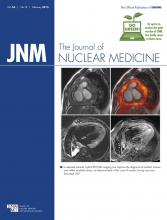Abstract
In idiopathic Parkinson disease and atypical parkinsonian disorders, central dopaminergic and overall brain functional activity are altered to different degrees, causing difficulties in achieving an unambiguous clinical diagnosis. A dual examination using 123I-FP-CIT (123I-N-ω-fluoropropyl-2β-carbomethoxy-3β-(4-iodophenyl)nortropane, or 123I-ioflupane) SPECT and18F-FDG PET provides complementary information on dopamine transporter (DAT) availability and overall brain functional activity, respectively. Parametric images based on a single, dynamic 11C-PE2I (N-(3-iodoprop-2E-enyl)-2β-carbomethoxy-3β-(4-methyl-phenyl)nortropane) scan potentially supply both DAT availability (nondisplaceable binding potential [BPND]) and relative cerebral blood flow (relative delivery [R1]) at voxel level. This study aimed to evaluate the validity of 11C-PE2I PET against the dual-modality approach using 123I-FP-CIT SPECT and 18F-FDG PET. Methods: Sixteen patients with parkinsonian disorders had a dual examination with 18F-FDG PET and 123I-FP-CIT SPECT following clinical routines and additionally an experimental 11C-PE2I PET scan. Parametric BPND and R1 images were generated using receptor parametric mapping with the cerebellum as a reference. T1-weighted MR imaging was used for automated definition of volumes of interest (VOI). The DAT VOIs included the basal ganglia, whereas the overall brain functional activity was examined using VOIs across the brain. BPND and R1 values were compared with normalized 123I-FP-CIT and 18F-FDG uptake values, respectively, using Pearson correlations and regression analyses. In addition, 2 masked interpreters evaluated the images visually, in both the routine and the experimental datasets, for comparison of patient diagnoses. Results: Parametric 11C-PE2I BPND and R1 images showed high consistency with 123I-FP-CIT SPECT and 18F-FDG PET images. Correlations between 11C-PE2I BPND and 123I-FP-CIT uptake ratios were 0.97 and 0.76 in the putamen and caudate nucleus, respectively. Regional 11C-PE2I R1 values were moderately to highly correlated with normalized 18F-FDG values (range, 0.61–0.94). Visual assessment of DAT availability showed a high consistency between 11C-PE2I BPND and 123I-FP-CIT images, whereas the consistency was somewhat lower for appraisal of overall brain functional activity using 123I-FP-CIT and 18F-FDG images. Substantial differences were found between clinical diagnosis and both neuroimaging diagnoses. Conclusion: A single, dynamic 11C-PE2I PET investigation is a powerful alternative to a dual examination with 123I-FP-CIT SPECT and 18F-FDG PET for differential diagnosis of parkinsonian disorders. A large-scale patient study is, however, needed to further investigate distinct pathologic patterns in overall brain functional activity for various parkinsonian disorders.
Footnotes
Published online Jan. 15, 2015.
- © 2015 by the Society of Nuclear Medicine and Molecular Imaging, Inc.







